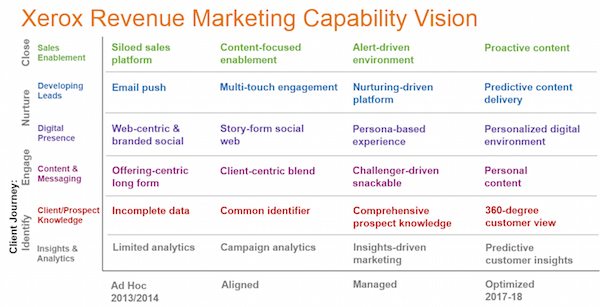The roles of marketing technologists — including senior chief marketing technologists — still have high variance from one organization to another.
In some, they are solo operators, serving as diplomats, translators, and expeditors between technical and marketing teams. In others, they run small teams under the label of something else, such as marketing operations or traditional IT.
But increasingly, we’re seeing full-fledged marketing technology and innovation teams, recognized as their own function within marketing, with significant staff and budget under their control. The impact they can have is nothing short of transformational, dramatically changing marketing’s capabilities and worldview.
Joseph Kurian, the Head of Marketing Technology & Innovation for Aetna, has built such a team. And in today’s Q&A, he gives us an in-depth look at how they’re organized, their collaboration with IT, how marketing is now pioneering innovation, and more.
Can you start by telling us about your background — what was your career path to your current position?
I started my career as a customer service rep answering phones in global trade services at a large financial institution. I cannot say enough about the experience gained working in customer service, as it teaches one to listen and relate to a customer’s perspective and then have to come up with solutions to deal with their issue. Over time I moved to various areas ranging from IT, capital markets, HR and marketing.
I was fortunate to develop a broad range of skills working with talented, mentoring peers. Employees that I managed also allowed me to learn a great deal about their perspective and how they viewed problems in their daily work lives. As I look back on it, my early career allowed me to develop an ability to empathize and identify with the problems from people with very different backgrounds. This would prove invaluable as I started down the road of my path in marketing technology management.
I plunged into the world of marketing technology about eight years ago, officially working in the marketing organization of a mature digital organization in the credit card industry. The experiences I gained there were invaluable in crystallizing my desire to focus my career around marketing technology, as I saw how important it was becoming in a rapidly changing digital marketing world.
The deeper I got into it, the more I realized that this place where marketing and technology intersected was the perfect place for someone with my technical and business skills, and it would very likely be where I focused my career. I was also fortunate to view, manage, or run a variety of different technologies in my career, which allowed me to understand the intricacies and complexities of these platforms and how they played in the larger technology network that they had to live in.
Once I moved into health care, it became obvious that this vertical needed marketing technology to progress in its digital maturity, much like financial services did years ago. I have continued to push on in this area as vendors and technologies have changed at a rapid pace, while marketing has continued to evolve in its need for marketing technologies that solve real business problems.
Can you describe your current role? How is marketing technology managed organized at Aetna?
I am the Head of Marketing Technology & Innovation for Aetna, the 3rd largest health insurer in the US with annual revenues of nearly $50B. I have several teams under me in the areas of marketing technology innovation, marketing technology platforms, wearables and health innovation, organic and site search, as well as some of our mobile product. We sit inside the Enterprise Marketing organization at Aetna, which in turn sits inside what is called the Consumer Business area.
Our many roles include internal consultants, educators, implementers, facilitators, and subject matter experts to name a few. Our core task is to bring a technology competency into the marketing organization to ensure that our digital marketers can focus on marketing, while we focus on their technology needs.
Our core task is to bring a technology competency into the marketing organization to ensure that our digital marketers can focus on marketing, while we focus on their technology needs.
However, the team also plays many other roles. We manage vendor relationships with marketing technology vendors to understand what their products and services can do for us in now, as well as the future. We constantly push the boundaries of the status quo for what we could and should be doing to drive digital maturity and innovation in our marketing space.
We work across all lines of business — yes, including IT — to ensure that what we are doing is not building a shadow IT org, but creating a collaborative technology partner that serves the needs of the business as well as the needs of our large technology organization.
What we are doing is not building a shadow IT org, but creating a collaborative technology partner that serves the needs of the business.
My staff is built with what we call “hybrids.” While this terminology certainly isn’t new, it is critical for success on my teams. Our people are comfortable with talking technology as well as having business use-cases and marketing value-prop conversations. This allows us to be technology consultants, business problem solution architects, marketing technology solution providers and drivers of innovative thinking in our space.
How did this marketing technology function come about? Can you share a bit of the business case you made? What concerns were raised in the process?
While I had many thoughts and ideas around this as a career for me, there is no question that finding the chiefmartec.com website and reading your work in this space heavily influenced my wanting to make this an official “role” for me. Prior to that, it had always been something I had done or been involved with, but not as a defined role or title.
In some cases — especially around innovation — it was primarily run off the side of my desk, in addition to the other tasks I had. What I learned was that if I wanted these tasks done effectively in an organization, I couldn’t have someone work on this in addition to their regular tactical responsibilities. I have found that innovation struggles to win in the tug-of-war of priorities between operational responsibilities and future thinking.
I have found that innovation struggles to win in the tug-of-war of priorities between operational responsibilities and future thinking.
The essence of the business case was primarily formulated on three pillars:
The first was the reality that marketing was becoming more technology dependent and would continue to do so in the future. Therefore the company would need an area that was familiar with marketing technology, how to best leverage and operationalize the tech and finally drive usage across the enterprise.
The second pillar was around letting marketers do marketing and stop worrying about vendors, technology, operationalizing, and driving usage and adoption of the internal technology. Digital marketers have a hard enough job driving usage and adoption of our customer facing digital assets — they don’t need more work. This also isn’t part of their core skills. While they need to be familiar with the technology, we don’t need them to be technologists. That work can be left to the people inside a marketing technology area.
The third pillar was focused on why traditional IT wasn’t the place to run this type of department. Having worked in a few IT organizations, this fact had been obvious to me for some time.
While IT is solid in areas of large technology infrastructure, security, scalability and management, many IT employees had very little experience in using these technologies in a large corporate environment. A true understanding of how these technologies work and are operationalized, their advantages for business partners, the SaaS based model — which doesn’t require much IT infrastructure for support — and the speed that these systems operated with required a very different skillset.
The role also required a strong understanding of business needs, business goals and a perspective for solutions to problems, coupled with the technology know-how. This is a complex blend that was not traditionally found in IT orgs.
Can you shed more light on the relationship between your team and IT? What’s the division of responsibilities? What things do you collaborate the most on?
With my experiences in IT, I certainly understand where IT can come from with their concerns around marketing technology. After I became the head of this area at Aetna, one of the first things I did was to reach out to IT leadership to make sure they understood what our role was inside the marketing organization and how we were looking to be partners with them rather than combatants. What I found was strong support amongst their leadership to the creation of a role like this inside the marketing organization. It helped to have someone who understood the perspective and point of view of the IT organization on the “inside.”
I found strong support among IT leadership for the creation of a role like this inside the marketing organization. It helped to have someone who understood IT on the “inside.”
They know that we would not do things that would compromise the security, stability and reliability of our systems, all important mainstays in every IT organizations core. However, we also know that many of the marketing technologies that we bring in and operate don’t always run in the traditional model that IT is used to supporting. Our ability to find the balance between the two is something we pride ourselves in, and I believe the IT organization recognizes and appreciates that.
The two areas where we collaborate the most are physical infrastructure and product selection. For anything that runs in our infrastructure, we ensure we are compliant with IT policies and governance, working with them to modify the rules where they are too inflexible or rigid for our needs. With product selection, we work with our enterprise architecture and app dev teams to coordinate what we are buying and bringing in and run through a process that covers business case, product selection and implementation.
Primarily the division of labor is split with IT owning the on-premise infrastructure for platforms we manage like web content management, as well as the application development function where we need that work done. For platforms that are SaaS-based, my team takes ownership for them, collaborating with various business partners as many of the tools in the marketplace have easy-to-use administrative console controls.
The division of labor is split with IT owning the on-premise infrastructure for platforms we manage, as well as the application development function. For platforms that are SaaS-based, my team takes ownership.
I will not pretend that we always see eye-to-eye with the IT organization on everything that we do. However, what we do make sure is that all parties understand what the point of view is from both sides and reach common ground for a solution. At the end of the day, we are both looking to drive the company forward, and it always benefits us to remember that.
I also want to call out our partnerships with the legal, compliance, security, privacy, and the procurement areas of our organization as well. These teams are critical in us being able to move forward on many of our initiatives, and in our regulated space we can’t do much without their buy-in. We have relationships with our peers in those areas, and all of us make sure that we are safeguarding the reputation of our organization as we try to move forward quickly.
I strongly believe that while most people think about marketing and IT being the two main players in marketing technology, it is critical that the areas mentioned above also understand why and what we are trying to do. The continued education of these groups in our technologies only serves to benefit us as an organization.
Let’s dive a little deeper into some of the innovation programs you’re running, such as the group exploring wearables. Why should these be run under marketing? Is there a framework for how these ideas will ultimately transfer from experiments in innovation to broader operational adoption?
I have two innovation groups on my team.
The first is Marketing Technology Innovation, and they look down the road 12-18 months and understand what we need to do in the present to position ourselves for success in the future. They are not necessarily concerned with the here and now, but rather what we need to do to mature in our digital capabilities for the future. This forward thinking is the only way that we ensure that we are driving ourselves forward. They are also the ones that meet vendors and service providers to understand what capabilities exist in the ever-changing marketplace.
[Our Marketing Technology Innovation group] are not necessarily concerned with the here and now, but rather what we need to do to mature in our digital capabilities for the future.
The second area is called Wearables and Health Innovation. As the name suggests, one of the main areas of focus are wearable technologies as they relate to the health ecosystem (Fitbit, Jawbone, Misfit, Withings, etc.) and marketing’s role in that ecosystem. As customers become more aware of their health and fitness levels and self-measure their daily activity, marketers need to understand what this means for us in our drive to help our customers lead healthier lives. Understanding how these technologies can play a part in the goals of our care management and wellness programs, to name a few, allows us to encourage and reward our customers in pursuing their health goals.
We also spend time thinking about what the developing ecosystem of the connected home, connected car and connected body means for the future. With more large companies developing new products and acquiring smaller niche companies, more devices talking to each other using common language protocols, and with this ecosystem maturing and starting to impact the lives of more and more people, we ask ourselves what can we do in our role to help our customers.
These challenges cause us to have to think outside of the traditional boundaries where we normally reside and push the organization in providing creative, innovative ideas for solutions.
What about the talent challenge? Who makes a great marketing technologist on your team? Are there different kinds? How do you find and develop people in these roles?
If there is one thing we all have in common, it is the struggle to find the right people for the roles we have on our teams. I look at many resumes, and they group in two general categories. In the first are marketing people who want to get into the space, but don’t have any experience in running or managing these technology platforms. In the other, you have technology folks who want to migrate over to the business side of things, but rarely have the experience in marketing technologies.
I typically break down my needs based on the level of the role I have open. For leadership positions on my teams, neither type of candidate works. I need people who have operationally been running these platforms with business partners. They also can’t just be tech-heads speaking bits and bytes. They need to have shown that they have worked closely with business teams, and most importantly understand the end-user perspective.
At the leadership level, this skill can’t be an on-the-job learning on my teams. They have to have instant street-cred when conversing with business partners and be able to fluently speak the language of marketing technology. They also need to be excellent presenters, have strong consulting and communication skills and an ability to influence without authority. I have used the term “hybrid” in this article before, and my leaders truly need to be hybrids in understanding technology and business.
They have to have instant street-cred when conversing with business partners and be able to fluently speak the language of marketing technology.
For roles below this leadership level, some of the candidates listed above might qualify. What we look for are people who use technology in their daily lives frequently, who are curious and inquisitive, who show an aptitude to understand concepts and pick up skills quickly, and who are confident when speaking to business partners to educate them on the technology or business process required to support the technology.
Most of the people I have found to be aligned with my needs in these roles are marketers with a strong technology DNA. These are usually people who are active on social media, use the latest smartphones, have tablets at home, in some cases do development work on their own time, work closely with the IT organization in their respective companies even without a tech role and are usually the ones chosen by marketing leadership to handle “that techy stuff.” I have been fortunate to have worked with many “digital ninjas” from marketing in the past and, I am even luckier to have teams staffed by them at Aetna.
What advice would you offer to people taking on your kind of role, managing marketing technology at this scale?
I would break that down into two categories.
If you are just starting to get into the marketing technology role, make sure you absorb everything you can about this space. Work with the areas in your company that use this technology, find ways to get assigned responsibilities on those platforms, and understand how the nitty-gritty works, because that knowledge will help you in the future. Read as much as you can about what vendors are doing, pay attention to the mergers and acquisition space, as it is constantly changing the marketing tech landscape, and constantly push yourself to understand how what you do impacts the bottom line of the company.
If you are coming into a leadership role in this area, you have probably been doing this work. What you need to make sure you have is strong support from your senior leadership. This is critical for the stability of the role and the associated annual budget.
The brightest ideas in large corporations go nowhere without allocated funds. They flash brightly and then a lack of sustainability douses the flash in short order. Make sure that you have a level of budget assigned to your work on an annual basis. As you show the value of your work and what the platforms can do for the organization, you can start to build the case for increases in those budgets.
The brightest ideas in large corporations go nowhere without allocated funds. They flash brightly and then a lack of sustainability douses the flash in short order.
You also need to be able to articulate why the role impacts the bottom line of the company. This could be around cost savings, revenue generation, or business process efficiency. Building the growth of your area and its budget around these factors is always time well spent.
I would also suggest you keep in mind that few companies cut the budgets of core, enterprise-wide systems. If you want to be successful, you need to make sure that the platforms you are bringing in can scale across the enterprise and support the needs of the broader organization. Combining that with the flexibility and agility of innovation teams forms a healthy balance for the team and the overall company.
Thanks, Joseph!



